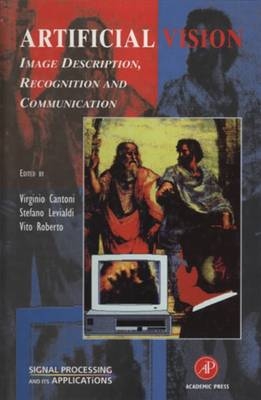
Artificial Vision
Academic Press Inc (Verlag)
978-0-12-444816-2 (ISBN)
Artificial Vision is a rapidly growing discipline, aiming to build computational models of the visual functionalities in humans, as well as machines that emulate them. Visual communication in itself involves a numberof challenging topics with a dramatic impact on contemporary culture where human-computer interaction and human dialogue play a more and more significant role.
This state-of-the-art book brings together carefully selected review articles from world renowned researchers at the forefront of this exciting area. The contributions cover topics including image processing, computational geometry, optics, pattern recognition, and computer science. The book is divided into three sections. Part I covers active vision; Part II deals with the integration of visual with cognitive capabilities; and Part III concerns visual communication.
Artificial Vision will be essential reading for students and researchers in image processing, vision, and computer science who want to grasp the current concepts and future directions of this challenging field.
Dr Stefano Levialdi, IEEE Life Fellow, has published 300 papers on image processing, image communication and, in these last years, his research has focused on Human/Computer Interaction (visual languages and usability). He is Full Professor of Computer Science at Sapienza, Rome University since 1981. He won the Chair of Excelence at Carlos III University in Madrid. He has organized, chaired and contributed to over 50 International meetings. He is the Director of LUA (Laboratory of Usability and Accessibility at Sapienza). He is now retired, but works for the Elsevier Journal (JVLC) and reviews national research projects. His email is: stefano.levialdi@gmail.com Virginio Cantoni received the Laurea (cum laude) in Electronic Engineering in 1972 from Pavia University, Italy. He was a researcher of the Italian National Research Council from 1975 to 1983, and is presently a Full Professor of Computer Programming at Pavia University. From 1989 to 1995 Cantoni was Director of the Deparment of Computer Engineering, and from 1985 to 1990, he was the President of the Italian Group of the International Association for Pattern Recognition. He has been a Visiting Professor at Rutgers University, and has been Invited Professor at the Paris XI University. Levialdi is a Fellow of the IAPR and a senior member of IEEE. Vito Roberto is Associated Professor at the Computer Science Faculty, University of Udine, Italy.
Preface. Part I: Active Vision: V. Cantoni, G. Caputo, and L. Lombardi, Attentional Engagement in Vision Systems. Y. Yeshurun, Attentional Mechanisms in Computer Vision. M. Savini, The Active Vision Idea. E. Trucco, Active Model Acquisition and Sensor Planning. A. Verri, The Regularization of Early Vision. Part II: Integrating Visual Modules: M. Bertolotto, E. Bruzzone, and L. DeFloriani, Geometric Modeling and Spatial Reasoning.V. Roberto, Vision as Uncertain Knowledge. V. Di Gesu and D. Tegolo, Distributed Systems for Fusion of Visual Infomation. E. Ardizzone, A. Chella, and S. Gaglio, Hybrid Computation and Reasoning for Artificial Vision. Part III: VisualCommunication: A.M. Iacono, Illusion and Difference. S. Levialdi, P. Mussio, N. Bianchi, and P. Bottoni, Computing with/on Images. A. Del Bimbo, Visual Databases. S-K. Chang, Visual Languages for Tele-Action Objects. Subject Index.
| Erscheint lt. Verlag | 19.9.1996 |
|---|---|
| Reihe/Serie | Signal Processing and Its Applications |
| Mitarbeit |
Herausgeber (Serie): Edward J. Powers, Doug Gray |
| Verlagsort | San Diego |
| Sprache | englisch |
| Maße | 152 x 229 mm |
| Gewicht | 570 g |
| Themenwelt | Informatik ► Grafik / Design ► Digitale Bildverarbeitung |
| Informatik ► Theorie / Studium ► Künstliche Intelligenz / Robotik | |
| ISBN-10 | 0-12-444816-X / 012444816X |
| ISBN-13 | 978-0-12-444816-2 / 9780124448162 |
| Zustand | Neuware |
| Haben Sie eine Frage zum Produkt? |
aus dem Bereich


